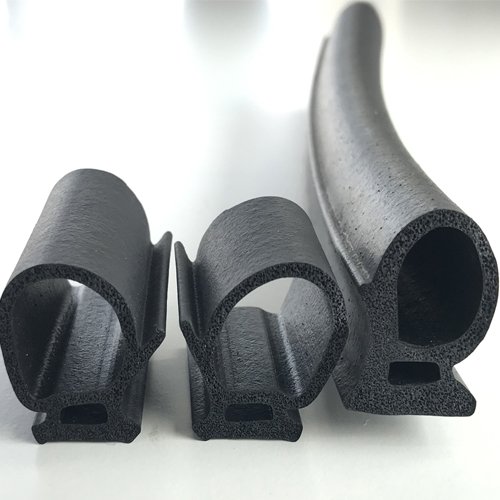Material Selection

Material Selection
Select right material for your application is critical for performance of rubber extrusion seals. Wrong material choice may lead to poor performance and short service life. So need to consider many factors before decide. Such as following question,
What is the Min and Max operating temperature?
What is the hardness required?
Where is it used for? Will it long time expose in sunshine?
Will it contact water, oil gases or other chemicals?
Do you have an estimate material cost? Normally specially rubber more expensive than a typical rubber or plastic and at same time require a higher minimum order quantity.
Following is material summary,
EPDM
EPDM rubber is widely used on rubber extrusion seals, it has excellent ozone aging resistance and weather resistance. EPDM rubber with good aging resistance, excellent chemical resistance, excellent water resistance and excellent electrical insulation properties. But EPDM rubber with low resistance to oil, petrol, fuels and flammable. Temperature resistance -40℃ to 120℃。
NITRILE (NBR)
Among general rubbers, nitrile rubber has the best resistance to oil, but its heat resistance is relatively low, and its cold resistance is worse than EPDM and CR. Nitrile rubber can be said to be a semiconductor rubber material with anti-static properties. Nitrile rubber is mainly used in various oil-resistant and anti-static products. Such as oil-resistant pipes, belts, sealing strips, sealing rings, oil seals; anti-static products such as textile rollers, aprons, etc. Nitrile rubber temperature resistance -30℃ to 120℃
NEOPRENE (CR)
CR is flame-retardant material because it contains chlorine atoms, that is not spontaneously combustible, it can burn when exposed to flame, and self-extinguishes away from the fire. CR has good heat resistance, ozone resistance and weather aging resistance.
CR is mainly used in flame-retardant, adhesive, medium-resistant, heat-resistant, weather-resistant, and medium-level electrical resistance. Such as wires and cables, adhesives, bridge supports, flame-retardant conveyor belts and air ducts, auto parts, coatings, corrosion-resistant linings, etc. Temperature resistance -30 ℃ to 150 ℃
SILICONE
Silicone with very good resist to ozone and UV, but with low tensile strength, tear strength and abrasion resistance. Silicone material is more expensive than EPDM, CR and NBR, but if the seal applications need very cold or high temperature, it will be the best choice. Silicone can operate under conditions from -50degrees to 260 degrees. This advantage withstand high heat makes silicone ideal for use like sealing autoclaves.
PVC
PVC(Vinyl) is an economical and versatile thermoplastic polymer widely used in building and construction industry to produce door and window profiles, pipes (drinking and wastewater), wire and cable insulation, medical devices, etc. Price is cheap than other material but usually rigid PVC tooling cost has a little expensive than flexible PVC tooling dies.
FKM (Viton)
Viton is a highly fluorinated polymer, so it offers exceptional performance in extremely hot and corrosive environments. It also offers superior resistance to aging, oxidizers, ozone, oils and various chemicals. However, Viton has limited use in low temperature environments. Cost of viton material is the highest material in all of rubber, temperature operating from -20drgees to 300 degrees.


